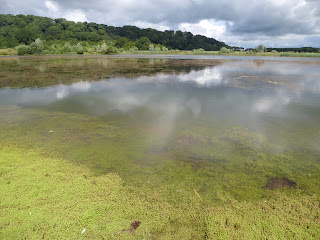A change of date as some people could not make the planned Saturday visit to Brockholes. The weather forecast indicated that rain would have stopped by 10:00 in the Preston area, but sadly this was inaccurate, so an early coffee seemed justified. The plan was to walk from the visitor centre around Meadow Lake to the hide and then alongside the river Ribble to reach the main area of the reserve. 'Roadworks', well pathworks, prevented this route, so a longer route past the car park to the Ribble was found. This diversion was rewarded on seeing a stand of yellow flowers of the Asteraceae family, generating the question: 'What is this?'
 |
| Broad-leaved Ragwort (Senecio sarracenicus) |
The initial identification was that of an extinct species, which seemed unlikely. Subsequently settled for Broad-leaved Ragwort (
Senecio sarracenicus) - new to all of us. Further checks later indicated it is not common in the UK, but locally frequent alongside the Ribble. The
National Biodiversity Network (NBN) records show numerous sightings from Clitheroe to Preston. We subsequently found another stand a little further along the river, but there were no flowers yet visible on these plants.
 |
| Broad-leaved Ragwort (Senecio sarracenicus) |
 |
| Broad-leaved Ragwort (Senecio sarracenicus) |
A Kingfisher flash was seen from the hide on Meadow Lake, which unfortunately lacked any seating, suggesting that the hide needed to be able to survive rough treatment. As the showers died away and the sun started to appear, the insects became more apparent. Common Blue Damselfly in particular was frequent everywhere. Brown Hawker Dragonflies were also numerous when we reached the lake called Number One Pit. Gatekeepers were the commonest butterflies, with the occasional Wall Brown, and probably a Peacock fleetingly. Tiny Froglets were surprisingly noticeable, suggesting many more than we actually saw.
 |
| New Zealand Pigmyweed (Crassula helmsii) |
One plant thriving, but presumably not considered desirable, was seen
around a few of the wet areas and extensively carpeting the shores of
Ribbleton Pool - the alien invader, New Zealand Pigmyweed (or Australian swamp-stonecop).
This plant used to be sold as an oxygenator, but was banned from April 2014. In slow-moving water such as ponds, lakes and canals it forms a dense, tangled growth of stems underwater, sometimes billowing up in cushions on the water surface.
 |
| New Zealand Pigmyweed (Crassula helmsii) |
 |
| Purple Loosestrife (Lythrum salicaria) |
Purple Loosestrife and Hedge Woundwort were both very frequent around the site.
 |
| Floating Visitor Village |
The dramatic, floating visitor centre looked very impressive. It apparently lived up to its name and intentions last winter when the water level rose by 4 metres (or so we were informed), and the buildings rose admirably to the challenge.
 |
| Fringed Water-lily (Nymphoides peltata) |
The water near the visitor centre contained not only the familiar Yellow and White Water-lilies, but also the less common, smaller and more delicate Fringed Water-lily.
Other birds seen during the day included Mallard, Tufted Duck, Canada Goose, Mute Swan, large flocks of Lapwing, Carrion Crow, Kestrel, Black-headed Gull, Pied Wagtail, Great Crested Grebe and a Sedge Warbler.
And additional flora: Water-plantain, Hogweed, Upright Hedge-parsley, Sneezewort, Lesser Burdock, Common Ragwort, Great Horsetail, Meadow Vetchling, Gypsywort, Great Willowherb, Common Spotted-orchid (a single flowering/fruiting spike), Silverweed, Reed Canary-grass, Common Reed and Great Reedmace.
For most of us, this was our first visit to Brockholes, despite being only a few minutes from junction 31 of the M6. It was a good day, and the site is certainly worth future visits.














